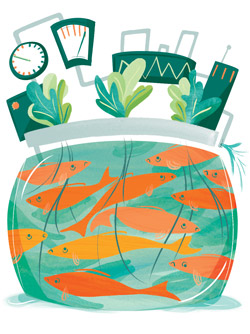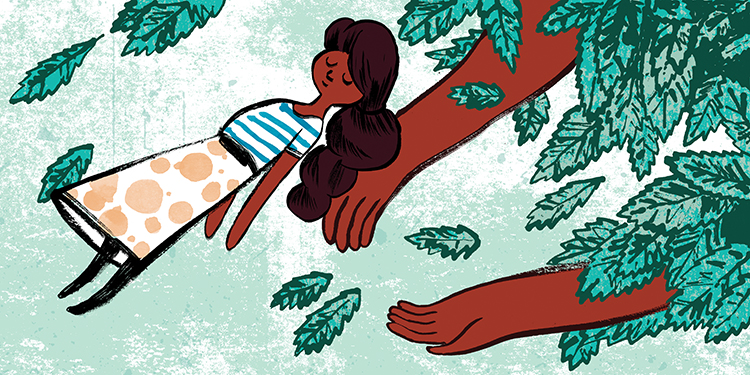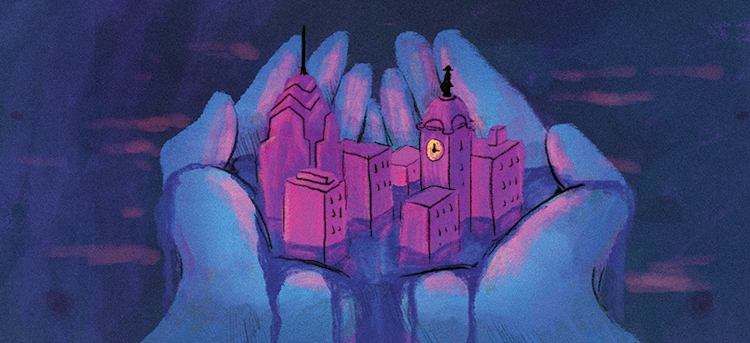A closed-loop system springs a leak
|
In 2010, my husband Ben and I had been bit by the small-farm bug. I had just swapped a career in managing concert venues and nightclubs to start working with farm and food businesses. He was a paramedic who had lived on a Kibbutz in Israel for four years milking cows, picking avocadoes and doing field work. |
 Illustration by Sarah FeroneWe had just moved into our first apartment in Philadelphia, but were sure that within five years we’d buy a farm and build something of our own. We grew sprouts, wheatgrass and greens under a small shop light. We hung upside-down tomato planters, with boxes of basil and cilantro underneath to catch the drainage. Our humble harvests had us wide-eyed, knowing that we were planting the seeds of our future.
Illustration by Sarah FeroneWe had just moved into our first apartment in Philadelphia, but were sure that within five years we’d buy a farm and build something of our own. We grew sprouts, wheatgrass and greens under a small shop light. We hung upside-down tomato planters, with boxes of basil and cilantro underneath to catch the drainage. Our humble harvests had us wide-eyed, knowing that we were planting the seeds of our future.
One day I came home from work, and Ben had surprised me by building our koi fish tank into an aquaponic herb planter. I was mesmerized watching the fish swimming through tunnels of dangling basil roots. Aquaponics is a soil-free cultivation that takes hydroponics to another level by creating an ecosystem that uses the fish waste for plant food. In hydroponics, the grower mixes nutrients into the water reservoir to feed the plants.
Wanting to experiment with both techniques, we traded in our dining room table for a 16-square-foot hydroponic system to grow greens. When our koi started to get too big for their tank, something clicked. Why not retrofit this hydro system to be fed by the fish and solve two problems at once? We were soon swept off our feet by aquaponics, watching every Murray Hallam video we could find on YouTube, and phrases like “closed-loop sustainable system” started peppering our dinner conversations. But soon our apartment was bursting at the seams with equipment, and tying to balance the flow of water for 10 hours a day wasn’t working. We kept springing leaks, which the bank below us did not appreciate.
So, we decided to move to the Wissahickon area and find a south-facing yard. Frimmer Family Farms was born at Lauriston Street in 2012. This was going to be our first foray into real farming—we were going to actually sell vegetables. The farm would be an experimental micro-farm to see how much could be produced in a 250 square foot space. We bought a hydroponic system with 300 plant sites and a pop-up garage that we modified into a high tunnel, growing tightly spaced, orderly rows of lettuce, kale, mustards and herbs for the local restaurant scene. Not exactly saving the world, but a pretty sweet first gig.
Hydroponics worked well as long as the weather was great. Without a true greenhouse and total environmental control, we had wild temperature fluctuations. There were days that our water temperatures reached 90+ degrees. The hydroponics pros have heaters, chillers and electronic nutrient dosing machines that constantly test and amend the water solution. We had none of that. A slew of problems meant that we were putting more lettuce in the compost pile than into bags for sale. We were total amateurs and we knew it.
Then came our “AHA!” moment—going back to aquaponics. Natural fertilizer, no water changes, koi that could be sold to landscapers; surely this would be more sustainable. The first few months were great, but then reality set in. Fish food was expensive and made of genetically modified soy, corn and cotton, forcing us to ship organic fish food from Florida. We had to use electricity to pump water and power fish tank heaters in winter. We still had water temperature issues, and then the filters and carrier tubes started clogging and leaks and blockages cost us entire crops—300 heads of lettuce—in one afternoon’s time. Our plants turned odd colors, and diagnosing problems became expensive and difficult. Not to mention that our water-grown greens were not as firm and delicious as greens grown in soil. We were so frustrated that we gave our fish away and went back to the drawing board. Outdoor aquaponics and hydroponics are not kind to the part-time farmer.
Then we had our next big moment of realization—soil is stable. Today, our farm has three 18-foot-long raised beds in the tunnel, each with a row of vertical stacking planters, giving us more planting sites than our previous compact hydro system. We also built eight more vertical planters for strawberries. Our old hydroponic tank brews bubbly compost tea. Now we actually enjoy our time on the farm. It doesn’t matter if the irrigation line busts, or it gets too hot, or if the nutrient solution is perfectly balanced, because things don’t happen so fast in the soil. Nature is in control, not us, and the results are beautiful and far more satisfying.
Rebecca Frimmer is Entrepreneur-in-Residence with Kitchen Table Consultants for farm and food businesses. The Frimmers continue to dive into all aspects of farming and are learning about no-till farming, carbon sequestration, and how farming practices affect global warming.




